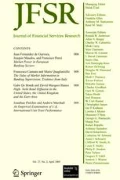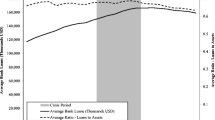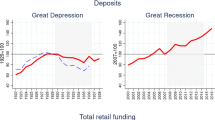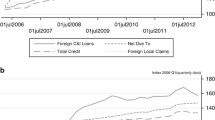Abstract
In September 2007, Northern Rock—the fifth largest mortgage lender in the United Kingdom—experienced an old-fashioned bank run, the first bank run in the U.K. since the collapse of City of Glasgow Bank in 1878. The run had been contained by the government’s announcement that it would guarantee all deposits in Northern Rock. This paper analyzes spillover effects during the Northern Rock episode and shows that both the bank run and the subsequent bailout announcement had significant effects on the rest of the U.K. banking system, as measured by abnormal returns on the stock prices of banks. The paper also shows that the effects were a rational response by investors to market news about the liability side of banks’ balance sheets. In particular, banks that rely on funding from wholesale markets were significantly affected, a result consistent with the drying up of liquidity in wholesale markets and the record-high levels of the London Interbank Offered Rate (LIBOR) during the crisis.


Similar content being viewed by others
Notes
Lindgren et al. (1996) show that, during the period 1980–96, of the 181 IMF member countries, 133 experienced significant banking problems. Such problems have affected developed as well as developing and transitional countries. Also see Dell’Ariccia et al. (2008) for an analysis of the real effects of banking crises.
See De Bandt and Hartmann (2002) for an excellent survey of theoretical and empirical models of systemic risk and the references therein for further discussion.
The timeline and the discussion here rely on the description of the Northern Rock episode in the October 2007 Financial Stability Report of the Bank of England (2007); the articles “Down the Drain” and “Lessons of the Fall” in the September 6, 2007 and October 18, 2007 issues of The Economist, respectively; and the BBC website: http://news.bbc.co.uk/2/hi/business/7007076.stm.
Northern Rock had only 76 branches in 2007 and retail deposits accounted for only 27 percent of its liabilities, whereas wholesale funding accounted for 68 percent of its liabilities, according to its interim results in June 2007. In January and May 2007, Northern Rock raised £10.7 billion through securitization, which made it the top securitizer among British banks.
This can arise due to the costs associated with changing banks that unsophisticated depositors incur, such as switching and searching costs. For example, data collected on current account switching behavior from the Financial Research Survey of the National Opinion Poll for the UK imply that a representative current account holder would only change banks every 91 years (Gondat-Larralde and Nier 2006).
According to the tripartite structure, the Bank of England, the Financial Services Authority, and the Treasury are mandated to deal with financial crises.
Acharya and Yorulmazer (2008) analyze various policy options to resolve bank failures such as liquidation, bailouts, and sale of a failed bank to a healthy bank, with and without government assistance. They show that, from a social welfare point of view, the sale of a failed bank to a healthy bank with government assistance can be preferable to bailing out the failed bank.
An announcement on September 21 confirmed and clarified the guarantees announced on September 20.
An important issue is whether there were other events, not directly related to the run on Northern Rock that might have confounded the effects. For example, Wall and Petersen (1990) extend Swary’s (1986) analysis of Continental Illinois and show that events related to U.S. banks’ holdings of claims on Latin America were confounding factors that needed to be included in the analysis. One such issue arises in our analysis for the effects of the bailout announcement. On September 19, at around noon, the Bank of England announced an injection of liquidity into the money markets and the extension of collateral to include mortgage debt, in an attempt to ease the liquidity crunch in wholesale markets. Hence, the returns on September 19 can be jointly affected by the bailout announcement on September 17 and the Bank of England’s announcement on September 19. To focus solely on the effect of the bailout announcement, we prefer to concentrate on returns for September 18.
The total assets of the ten banks in the study are approximately £4441 billion, which is around 317 percent of the U.K. GDP (£1401 billion) in 2007. The total assets of Alliance & Leicester, Bradford & Bingley and HBOS—the three banks on which we found significant spillover effects—are approximately £710 billion, which is around 51 percent of the U.K. GDP in 2007. Furthermore, spillover effects during September 14–17 wiped out 59, 32 and 14 percent of Tier 1 capital of Alliance & Leicester, Bradford & Bingley, and HBOS, respectively.
O’Hara and Shaw (1990) study the effect of the announcement of the too-big-to-fail guarantee by the U.S. Office of the Comptroller of the Currency, and find a positive value effect for the largest banks.
On September 19, at around noon, the Bank of England announced an injection of liquidity into the money markets and the extension of collateral to include mortgage debt. As a result, we chose to focus only on September 18 to analyze the effect of the bailout announcement. However, on September 19, Bradford & Bingley experienced a significant positive abnormal return (7.5 percent, significant at the 1 percent level). Hence, the cumulative abnormal return for Bradford & Bingley is 11.8 percent for September 18–19, which would only make the results of the paper stronger. While the failure of Northern Rock is clearly bad news for other banks that pursue the same business model, the announcement on September 18 contains some uncertainty about the government’s future response to difficulties in other banks. Even though the announcement on September 18 may imply that similar guarantees might be provided for other banks in the future, this potential guarantee is not explicit. Hence, the uncertainty about future government interventions still remains, which mitigates the effect of the government intervention. However, one can interpret the announcement on September 19 as indicative of the authorities’ willingness to intervene, which would have reduced the uncertainty about government interventions. Hence, the effects we find for the government intervention could be expected to serve as a lower bound for the effect of the bailout announcement.
Consistent with the October 2007 Financial Stability Report of the Bank of England, we define wholesale funding as the sum of debt securities in issue and the deposits from other banks.
Inclusion of Northern Rock makes the results stronger.
The other three explanatory variables, deposit, size, and capital, mostly have the expected signs, but they are highly insignificant.
Wholesale is significant at the 5 percent level for September 14–17, significant at the 10 percent level for September 14 and September 17, whereas the p-value is 0.12 for September 18.
This finding is consistent with Shin (2009), who argues that Northern Rock’s reliance on institutional investors for short-term funding made it extremely vulnerable to the drying up of liquidity in credit markets.
Results are available from the authors upon request.
A further confirmation for the robustness of our results is the subsequent failures (or near failures) of the institutions we show to have been affected. In particular, in the aftermath of Lehman’s failure, the takeover of Alliance & Leicester by the Spanish bank Grupo Santander was ratified by shareholders on September 16, 2008; the U.K. government announced that Bradford & Bingley had been partly nationalized and that Grupo Santander had purchased the savings business on September 29, 2008; Lloyds TSB’s acquisition of HBOS was announced on September 19, 2008, effective on January 19, 2009; and HBOS’ pre-tax loss of £10.8 billion in 2008 hit Lloyds TSB, which had to be recapitalized by the U.K. government. As the sequence of events confirms, the effects we found were neither spurious nor idiosyncratic; rather, they can be systematically explained by the business model of the affected banks.
References
Acharya V, Yorulmazer T (2008) Cash-in-the-market pricing and optimal resolution of bank failures. Rev Financ Stud 21(6):2705–2742
Aharony J, Swary I (1983) Contagion effects of bank failures: evidence from capital markets. J Bus 56(3):305–317
Allen F, Gale D (1998) Optimal financial crises. J Finance 53:1245–1283
Allen F, Gale D (2000) Financial contagion. J Polit Econ 108:1–33
Bank of England (2007) Financial stability report. October, 22, pp 5–15
Bryant J (1980) A model of reserves, bank runs and deposit insurance. J Bank Financ 4:335–344
Calomiris C, Gorton G (1991) The origins of banking panics: models, facts, and bank regulation. In: Hubbard G (ed) Financial markets and financial crises. University of Chicago Press, Chicago
Calomiris C, Kahn C (1991) The role of demandable debt in structuring optimal banking arrangements. Am Econ Rev 81:497–513
Calomiris C, Mason J (1997) Contagion and bank failures during the great depression: the June 1932 Chicago Banking Panic. Am Econ Rev 87(5):863–883
Calomiris C, Mason J (2003) Fundamentals, panics and bank distress during the depression. Am Econ Rev 93(5):1615–1647
Campbell JY, Lo AW, MacKinlay AC (1997) The econometrics of financial markets. Princeton University Press, Princeton
Carron AS (1982) Financial crises: recent experience in U.S. and international markets. Brookings Pap Econ Act 2:395–418
Chari VV, Jagannathan R (1988) Banking panics, information and rational expectations equilibrium. J Finance 43:749–60
Chen Y (1999) Banking panics: the role of the first-come, first-served rule and information externalities. J Polit Econ 107(5):946–968
Cifuentes R, Ferucci G, Shin HS (2005) Liquidity risk and contagion. Journal of the European Economic Association 3(2–3):556–566
Cooperman ES, Lee WB, Wolfe GA (1992) The 1985 Ohio thrift crisis, the FSLIC’s solvency and rate contagion for retail CDs. J Finance 47(3):919–941
De Bandt O, Hartmann P (2002) Systemic risk: a survey. In: Goodhart C, Illing G (eds) Financial crisis, contagion and the lender of last resort: a book of readings. Oxford University Press, Oxford, pp 249–298
Dell’Ariccia G, Detragiache E, Rajan R (2008) The real effect of banking crises. J Financ Intermed 17(1):89–112
Diamond D, Dybvig PH (1983) Bank runs, deposit insurance and liquidity. J Polit Econ 91:401–419
Diamond D, Rajan R (2001) Liquidity risk, liquidity creation and financial fragility: a theory of banking. J Polit Econ 109:2431–2465
Gondat-Larralde C, Nier E (2006) Switching costs in the market for personal accounts: some evidence for the United Kingdom. Bank of England working paper no 292
Gorton G (1988) Banking panics and business cycles. Oxf Econ Pap 40:751–781
Gorton G, Huang L (2004) Liquidity, efficiency and bank bailouts. Am Econ Rev 94:455–483
Hasan I, Dwyer GP (1994) Bank runs in the free banking period. Journal of Money, Credit, and Banking 26:271–288
Huang R, Ratnovski L (2008) The dark side of wholesale funding. Working paper, Federal Reserve Bank of Philadelphia
Huang R, Ratnovski L (2009) Why are Canadian banks more resilient? IMF working paper no 09/152
Jayanti S, Whyte AM (1996) Global contagion effects of the continental illinois failure. J Int Financ Mark Inst Money 6(1):87–99
Lang L, Stulz R (1992) Contagion and competitive intra-industry effects of bankruptcy announcements. J Financ Econ 32:45–60
Lindgren C-J, Garcia G, Saal MI (1996) Bank soundness and macroeconomic policy, international monetary fund. Washington, DC
MacKinlay AC (1997) Event studies in economics and finance. J Econ Lit 35:13–19
Morgan D, Stiroh KJ (2001) Market discipline of banks: the asset test. J Financ Serv Res 20:195–208
O’Hara M, Shaw W (1990) Deposit insurance and wealth effects: the value of being ‘Too Big to Fail’. J Finance 45(6):1587–1600
Saunders A (1987) The interbank market, contagion effects and international financial crises. In: Portes R, Swoboda AK (eds) Threats to international financial stability. Cambridge University Press, New York, pp 196–232
Saunders A, Wilson B (1996) Contagious bank runs: evidence from the 1929–1933 period. J Financ Intermed 5:409–423
Schoenmaker D (1996) Contagion risk in banking. L.S.E. Financial Markets Group Discussion Paper, No 239
Schumacher L (2000) Bank runs and currency run in a system without a safety net: Argentina and the ‘Tequila’ Shock. J Monet Econ 46:257–277
Shin HS (2009) Reflections on modern bank runs: a case study of Northern rock. J Econ Perspect 23(1):101–119
Slovin M, Sushka M, Polonchek J (1992) Information externalities of seasoned equity issues: difference between banks and industrial firms. J Financ Econ 32:87–101
Slovin M, Sushka M, Polonchek J (1999) An analysis of contagion and competitive effects at commercial banks. J Financ Econ 54:197–225
Swary I (1986) Stock market reaction to regulatory action in the continental Illinois crisis. J Bus 59(3):451–473
Wall L, Petersen D (1990) The effect of continental Illinois’ failure on the financial performance of other banks. J Monet Econ 26:77–99
Author information
Authors and Affiliations
Corresponding author
Additional information
The views expressed in this paper are those of the authors and do not necessarily reflect the views of the Federal Reserve Bank of New York or the Federal Reserve System. Part of this project was completed while Paul Goldsmith-Pinkham was at the Federal Reserve Bank of New York. We are grateful to Viral Acharya, Robert DeYoung (editor), Douglas Gale, Beverly Hirtle, Donald Morgan, Ihab Seblani, David Skeie, Til Schuermann, Hyun Shin, Haluk Unal (editor) and an anonymous referee for helpful suggestions.
Rights and permissions
About this article
Cite this article
Goldsmith-Pinkham, P., Yorulmazer, T. Liquidity, Bank Runs, and Bailouts: Spillover Effects During the Northern Rock Episode. J Financ Serv Res 37, 83–98 (2010). https://doi.org/10.1007/s10693-009-0079-2
Received:
Revised:
Accepted:
Published:
Issue Date:
DOI: https://doi.org/10.1007/s10693-009-0079-2




